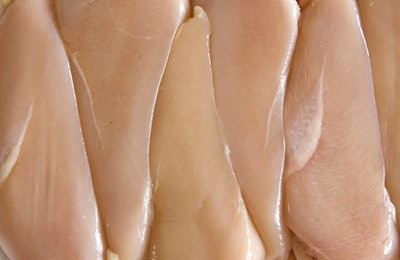
A new research project from the University of Arkansas will use accelerometers – the technology used to measure steps in Fitbits – and artificial intelligence to identify woody breast and other meat quality defects in chickens.
Woody breast is one of the costliest meat quality defects in the poultry industry, resulting in substantial economic losses due to lost yield, increased labor costs and lost business because of customer dissatisfaction.
“Woody breast is a muscle myopathy that takes place during bird growth and development, affecting the breast fillet by allowing collagen and/or fat to come in. This changes the composition of the muscle and affects the taste,” Casey Owens, the Novus International Professor of Poultry Science at the Arkansas Agricultural Experiment Station, the research arm of the Division of Agriculture, said.
Cooked chicken meat with woody breast tastes rubbery, tough and crunchy and is generally unpalatable for customers.
Measuring vibrations
For the research, the scientists plan to use accelerometers to measure vibration patterns in deboned chicken breasts with and without woody breast. They believe that more rigid muscle – an indicator of wooden breast – will respond to the vibrations differently than normal muscle.
“In the computer science field, there have been numerous applications for accelerometers. Today, accelerometers can detect even very subtle movements or vibrations when used in the correct way,” explained Qinghua Li, associate professor in the University of Arkansas department of computer science and computer engineering.
“In preliminary experiments, it has worked very well at detecting the differences in vibration patterns between muscle with increased collagen and normal muscle.”
Artificial intelligence will be used to analyze and identify the differences between woody breast and normal muscle.
The project, scheduled to begin this fall, is funded by a research grant from the U.S. Poultry & Egg Association.
The team hopes that this project will eventually result in a commercial product that can be used in plants and real-world situations to identify woody breast in live birds.
Like what you just read? Sign up now for free to receive the Poultry Future Newsletter.


















